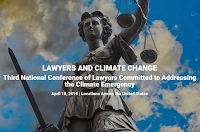The newly elected premiere of Alberta Jason Kenney has threatened the Federal Liberals, the province of BC, environmentalists and anyone who opposes fossil fuels. The fossil fuel industry was a central campaign issue for the new premier. Kenney uttered a bizarre warning for environmentalists who he outlandishly claimed are part of a foreign conspiracy to undermine Alberta's fossil fuel industry.
In a Trump style public relations move meant to pander to his base Kenney claimed he will launch a public inquiry into the matter. He is scapegoating environmentalists and going after well respected groups like the David Suzuki Foundation and the Tides Foundation. These are cynical political ploys meant to undermine those that oppose his dirty energy agenda.
Kenney has also threatened to pass legislation that will cut the flow of oil to BC to punish the province for its resistance to the expansion of the Trans Mountain pipeline.
At an April rally in Fort McMurray Kenney said the UCP government is ready to take on both the province of BC and Prime Minister Justin Trudeau’s Liberal government.
He has said he will go to court in a bid to kill national carbon pricing schemes and he has also vowed to try to make it difficult to impose carbon taxes in the future. He has also promised to work to get the federal Conservatives elected. On April 11th Andrew Scheer, the leader of the federal Conservatives, secretly met with oil industry executives in a day long meeting to discuss strategies to win the federal election.
The meeting included leaders of four oil companies, conservative organizers and the president of Canada's largest oil patch lobby group, the Canadian Association of Petroleum Producers. It also included an oil advocacy group called the Modern Miracle Network.
There is some question as to whether the lack of transparency associated with this meeting contravenes Canadian laws pertaining to anti-collusion with third-party groups and political parties. When Scheer was called out for the secret meeting he responded in a Facebook post saying, "I will not apologize for standing up for Canada’s oil and gas workers and to defeat a government that is intent on phasing them out."
Environment and Climate Change Minister Catherine McKenna responded on Twitter saying:
In a Trump style public relations move meant to pander to his base Kenney claimed he will launch a public inquiry into the matter. He is scapegoating environmentalists and going after well respected groups like the David Suzuki Foundation and the Tides Foundation. These are cynical political ploys meant to undermine those that oppose his dirty energy agenda.
Kenney has also threatened to pass legislation that will cut the flow of oil to BC to punish the province for its resistance to the expansion of the Trans Mountain pipeline.
At an April rally in Fort McMurray Kenney said the UCP government is ready to take on both the province of BC and Prime Minister Justin Trudeau’s Liberal government.
He has said he will go to court in a bid to kill national carbon pricing schemes and he has also vowed to try to make it difficult to impose carbon taxes in the future. He has also promised to work to get the federal Conservatives elected. On April 11th Andrew Scheer, the leader of the federal Conservatives, secretly met with oil industry executives in a day long meeting to discuss strategies to win the federal election.
The meeting included leaders of four oil companies, conservative organizers and the president of Canada's largest oil patch lobby group, the Canadian Association of Petroleum Producers. It also included an oil advocacy group called the Modern Miracle Network.
There is some question as to whether the lack of transparency associated with this meeting contravenes Canadian laws pertaining to anti-collusion with third-party groups and political parties. When Scheer was called out for the secret meeting he responded in a Facebook post saying, "I will not apologize for standing up for Canada’s oil and gas workers and to defeat a government that is intent on phasing them out."
Environment and Climate Change Minister Catherine McKenna responded on Twitter saying:
"Straight from Harper's playbook: Andrew Scheer has been caught scheming behind closed doors with wealthy executives to gut environmental protection laws, silence critics, and make pollution free again...We're working with Canadians everywhere to find common ground and put solutions into action that protect nature and fight climate change. Meanwhile, Scheer and his powerful friends plan to slap critics with lawsuits and smear campaigns."Scheer replied by reposting a December, 2018 video of himself participating in a pro-oil truck convoy in Alberta. He wrote, "While Justin Trudeau's Liberals want to phase out Canada's energy workers, I am not ashamed of fighting for them – and it's no secret."

















